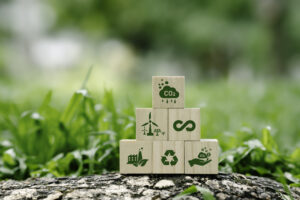Read the policy briefing: “Industrial transformation policies: Green public procurement for construction materials”
The drive to innovate that has resulted from the need to meet today’s decarbonisation objectives has given rise to a new industrial revolution based on clean technology. This has triggered a profound transformation in production systems and has reconfigured the global competitive landscape. If, in such a context, Europe and Italy are to continue playing a strategic role, climate change policies must look to preserve their strategic autonomy, whilst also maintaining the Continent’s competitiveness.
The challenge of undertaking an industrial transformation that aligns with decarbonisation objectives is particularly complex. This is especially true for energy-intensive production processes, where the physical and chemical procedures required generate greenhouse gases, since the carbon content is an inherent feature of the raw materials used. This is the case, for example, in the production of construction materials such as steel and cement.
Globally, approximately 50% of the climate impact from construction (the built environment), assessed over the entire life cycle, derives from the use of concrete, bricks and other cement-based materials, while the remainder is attributed to the use of metals (15%), fossil fuels (29%) and biomass (10%).
As was recently underlined by two papers analysing the industrial transformation policies for the steel and cement industries, for complex sectors such as those involved in the manufacture of construction materials, any emissions reduction strategy must focus on a range of solutions that can be implemented over time. To this end, a portfolio of industrial policies with varying priorities is required, coordinated and integrated in such a way so as to ensure that the actions aimed at both the supply and demand sides of the equation are fully coordinated. These include: supply-side support policies, to tackle issues relating to the need to fund investment and meet higher energy costs; demand-side incentive and protection mechanisms to facilitate the development of a market that can provide a vehicle for the commercialisation of more expensive green products.
The new policy guidelines of the European Commission, along with the Draghi report, also recognise the need to stimulate demand for green products by introducing standardised criteria for public procurement that encourage the use of low-carbon materials.
Green Public Procurement – GPP
In Europe, each year, more than 14% of GDP, approximately €2 trillion, is spent by over 250,000 public authorities to pay for services, works and goods. Of this, an estimated €13.4 billion is spent on construction materials. In Italy, the total amount spent on public procurement contracts with a value of €40,000 or more is approximately €283.4 billion. In 2019, Italy’s public spending in the construction and infrastructure sector amounted to €48 billion.
By using green products and facilitating their procurement, public administrative bodies can help drive industry towards more sustainable production, acting as a catalyst for growing the demand for climate-compatible products, even in private markets. Indeed, the purchasing decisions of public authorities can certainly encourage innovation in clean technologies by providing access to economies of scale, even for smaller companies and start-ups.
This policy briefing, which analyses the current situation in relation to public procurement legislation in Europe and Italy, sets out a proposal for revising the minimum environmental criteria (Criteri Ambientali Minimi – CAMs) for the public procurement of construction materials, which are currently under review.
Read the policy briefing
This policy briefing was prepared by ECCO – the Italian climate change think tank, in collaboration with Fondazione Ecosistemi, within the project National support to ECOS work on GPP for construction products – Steel, cement and concrete.
Photo by piranka








